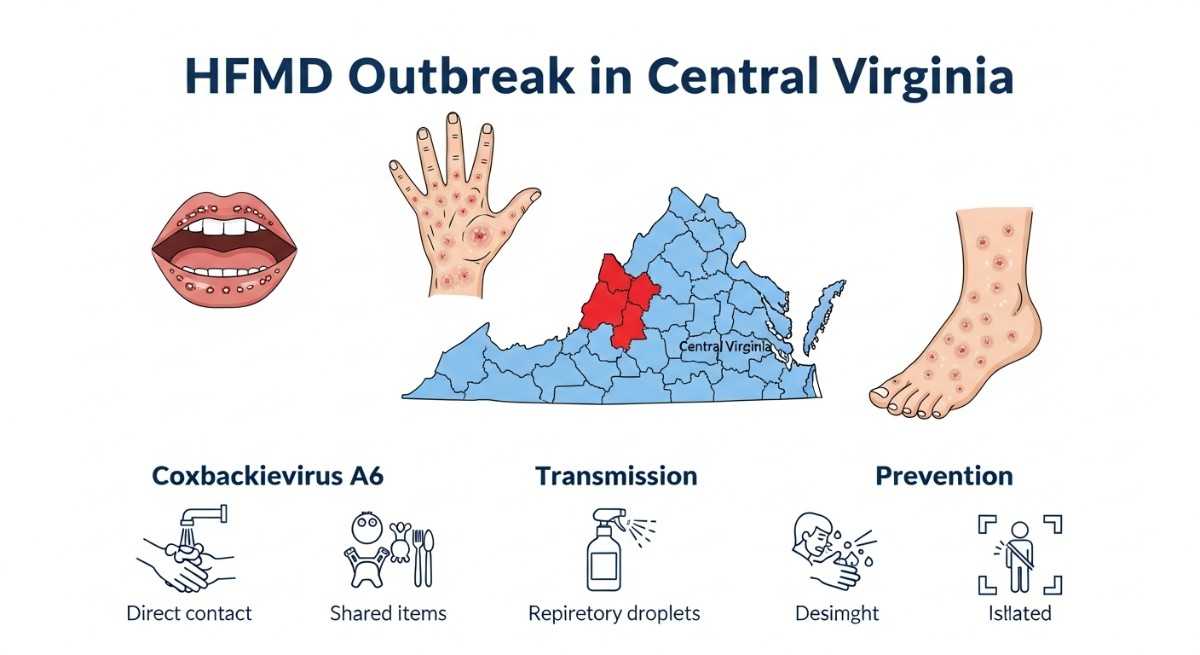Great Health Great Fitness
Hand, Foot, and Mouth Disease Surge in Central Virginia Linked to Severe Strain

Central Virginia, October 18, 2025 – Health officials in Central Virginia are reporting a significant surge in cases of Hand, Foot, and Mouth Disease (HFMD), raising concerns about the spread of the more severe Coxsackievirus A6 strain. Schools, daycare centers, and community spaces have seen the sharpest rise in infections in recent years, prompting heightened awareness campaigns and preventive measures by local health authorities.
Sharp Rise in Cases
According to the Virginia Department of Health (VDH), HFMD outbreaks have more than tripled this year compared to previous seasons. Since May 2025, over 165 outbreaks have been reported across Central Virginia, compared to the typical 45–60 cases per year. The majority of infections are concentrated in elementary schools, daycare centers, and family childcare facilities, putting both children and staff at risk.
Dr. Karen Willis, an infectious disease specialist with the VDH, explained, “This strain of HFMD is behaving differently from previous years. The virus appears to be more contagious, and in some cases, it is causing more severe symptoms than the strains we are used to seeing.”
Understanding Coxsackievirus A6
HFMD is a viral infection commonly seen in young children, typically under the age of 10. While it has historically caused mild symptoms, Coxsackievirus A6 has been linked to more intense cases, including:
- Painful sores around the mouth and throat
- Red or blister-like bumps on the hands, feet, and sometimes genitals
- Fever, fatigue, and irritability
- Occasional complications, such as dehydration, when children refuse to eat or drink due to painful sores
Unlike milder HFMD strains, the Coxsackievirus A6 strain can occasionally affect older children, teens, and adults, making this outbreak particularly concerning for families and caregivers.
How the Virus Spreads
HFMD spreads primarily through direct contact with an infected person’s:
- Saliva or nasal secretions
- Blister fluid
- Fecal matter (from unwashed hands or contaminated surfaces)
Close contact in schools, daycares, playgrounds, and family gatherings significantly increases transmission risk. Dr. Willis emphasizes, “Parents should understand that children can be contagious even before symptoms appear. This makes prevention and early detection extremely important.”
Preventive Measures and Recommendations
Health officials are urging residents to take proactive steps to limit the spread of HFMD:
- Frequent Handwashing – Wash hands thoroughly with soap and water after using the restroom, before meals, and after touching potentially contaminated surfaces.
- Disinfecting Surfaces – Regularly clean toys, door handles, countertops, and shared equipment with appropriate disinfectants.
- Isolating Infected Individuals – Keep children with symptoms at home until they recover, to prevent transmission to classmates and staff.
- Monitoring Symptoms – Watch for early signs such as fever, sore throat, or unusual rashes and consult healthcare providers promptly if symptoms escalate.
- Avoid Sharing Items – Encourage children not to share utensils, cups, towels, or clothing with others while sick.
Community and School Response
Several schools in Central Virginia have already implemented enhanced sanitation protocols, including frequent cleaning of classrooms, cafeterias, and restrooms. Some daycare centers have temporarily reduced class sizes or staggered schedules to minimize contact between children. Health educators are also distributing informational pamphlets and holding parent workshops to explain the risks, symptoms, and preventive actions.
Parents like Angela Thompson from Richmond shared her concerns: “My two kids caught HFMD last month. It started with a small fever and blisters in their mouths. Thankfully, they recovered quickly, but it was scary seeing them in pain. We’re now extra careful with handwashing and disinfecting at home.”
Public Health Perspective
While HFMD is generally not life-threatening, the current surge in Coxsackievirus A6 cases is prompting heightened vigilance. Dr. Willis noted, “The goal is to keep the community informed and prepared. Most children will recover fully, but outbreaks like this can disrupt schools and workplaces if precautions aren’t taken.”
She also advised that adults with weakened immune systems or underlying conditions should take extra precautions, as the virus can occasionally cause more severe illness in vulnerable populations.
Looking Ahead
Health experts predict that HFMD will continue to circulate through Central Virginia until winter months, when the virus typically slows. They encourage parents, teachers, and caregivers to remain alert and maintain rigorous hygiene practices to minimize the spread.
The VDH is closely monitoring the outbreak and will continue updating the public on trends, preventive measures, and recommended protocols for schools and childcare facilities.
Key Takeaways
- HFMD cases in Central Virginia have tripled in 2025 due to the Coxsackievirus A6 strain.
- Symptoms include mouth sores, blisters on hands and feet, fever, and fatigue.
- Young children are the most affected, but teens and adults may also contract the virus.
- Frequent handwashing, disinfecting surfaces, and keeping sick children home are critical to stopping the spread.
- Public health officials are urging communities to stay informed, vigilant, and proactive.
For more information about HFMD and preventive strategies, visit the Virginia Department of Health HFMD Fact Sheet.
